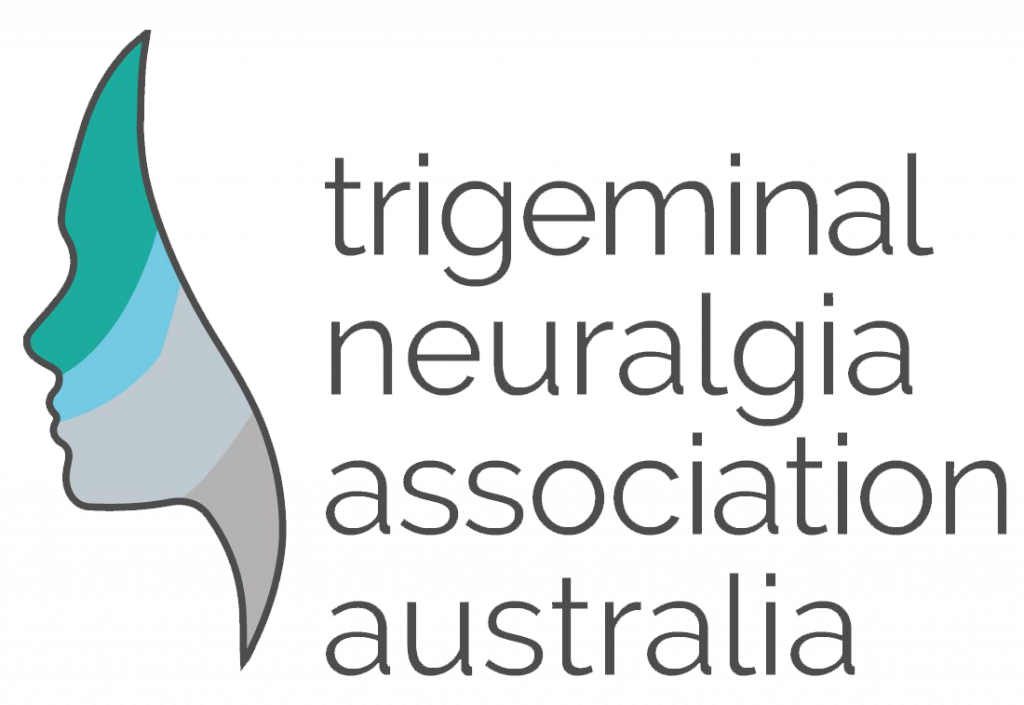The following paper covers various Pain Theory Models. It is interesting to see how modern medicine derives it’s knowledge and how these theories are applied in practice.
This specific theory of pain hypothesizes that pain is the result of complex interactions between biological, psychological, and sociological factors, and any theory which fails to include all of these three constructs of pain, fails to provide an accurate explanation for why an individual is experiencing pain.
Overview of Pain Theory
Introduction:
Chronic pain has multiple aetiological factors and complexity. Pain theory helps us to guide and organize our thinking to deal with this complexity. The objective of this paper is to critically review the most influential theory in pain science history (the gate control theory of pain) and focus on its implications in chronic pain rehabilitation to minimize disability.
Methods:
In this narrative review, all the published studies that focused upon pain theory were retrieved from Ovoid Medline (from 1946 till present), EMBAS, AMED and PsycINFO data bases.
Results:
Chronic pain is considered a disease or dysfunction of the nervous system. In chronic pain conditions, hypersensitivity is thought to develop from changes to the physiological top-down control (inhibitory) mechanism of pain modulation according to the pain theory. Pain hypersensitivity manifestation is considered as abnormal central inhibitory control at the gate controlling mechanism. On the other hand, pain hypersensitivity is a prognostic factor in pain rehabilitation. It is clinically important to detect and manage hypersensitivity responses and their mechanisms.
Conclusion:
Since somatosensory perception and integration are recognized as a contributor to the pain perception under the theory, then we can use the model to direct interventions aimed at pain relief. The pain theory should be leveraged to develop and refine measurement tools with clinical utility for detecting and monitoring hypersensitivity linked to chronic pain mechanisms.
“Pain is as elemental as fire or ice. Like love, it belongs to the most basic human experiences that make us who we are.” (Morris 1993, 1)
Pain Theory -NCBI Paper NBK545194
Lindsay A. Trachsel; Sunil Munakomi; Marco Cascella.
Author Information and Affiliations
Last Update: April 17, 2023.
Definition/Introduction
An individual’s capacity to feel pain is an essential component of the body’s ability to heal. Pain is the body’s way of telling us there is an injury, and we need to do something about it to ensure that healing occurs. An important consideration when talking about pain is the fact that one patient’s pain is not the same as another patient’s pain, even if they have experienced similar injuries. Pain perception, indeed, is a subjective experience, influenced by complex interactions of biological, psychological, and social factors.
Although inflammation and pain are an essential part of healing (acute pain), in some circumstances, they can lead to negative effects. Several mechanisms involving the activation of peripheral and central sensitization pathways through the sensitization of peripheral nociceptors, and alterations in spinal dorsal horn neurons, and central nervous system (CNS) brain areas, can trigger a pathogenetic cascade that ends with the development of chronic pain. Again, pieces of evidence suggest the paramount role of the environment (i.e., epigenetic) and genetics. Thus, the chronicity of pain is the effect of changes in pain processing through transcription and transduction processes. As a consequence, chronic pain is no longer simply a symptom but becomes itself a disease. Currently, in the United States, estimates are that 100 million individuals suffer from the negative effects of protracted courses of pain and inflammation. This epidemic is growing at an alarmingly fast rate and is taking a significant toll on the economy as well as patients and providers. In fact, there are reports that the cost for chronic pain patients is anywhere between 560 to 635 billion dollars annually. Furthermore, increased opioid prescription and use, until opioid addiction in the United States and Canada is a dramatic phenomenon that has been responsible for up to 70.000 drug overdose deaths, in 2017. Although it appears that in other countries (e.g., Western Europe) the data is not so alarming.
The underlying foundations of pain perception (and its processing) represent a field of study that has interested researchers for centuries. Throughout the history of medicine, several theories have been proposed to explain why and how individuals feel the pain they feel. Although the beliefs about where the pain originates have varied throughout the years, the desire to elucidate this phenomenon has led to the proposal of many different philosophies. The pain theories that this activity will discuss below include the intensity theory, Cartesian dualism theory, specificity theory, pattern theory, gate control theory, neuromatrix model, and biopsychosocial. The topic has not only historical and didactic interests but involves important practical and therapeutic implications.
Issues of Concern
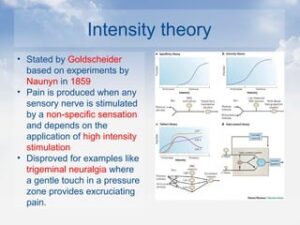
Intensity Theory
The theory goes back to the Athenian philosopher Plato (c. 428 to 347 B.C.) who in his work Timaeus, defined pain not as a unique experience, but as an ’emotion’ that occurs when the stimulus is intense and lasting. Centuries later, we are aware that especially chronic pain represents a dynamic experience, profoundly changeable in a spatial-temporal manner. A series of experiments, conducted during the nineteenth century, sought to establish the scientific basis of the theory. These investigations, based on the tactile stimulation and impulses of other nature such as electrical stimulations, provided important information concerning the threshold for tactile perceptions and the role of the dorsal horn neurons in the transmission/processing of pain.
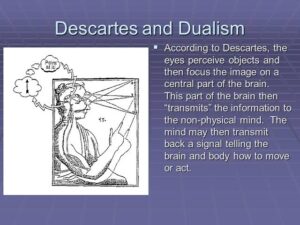
Cartesian Dualistic Theory
The oldest explanation for why pain manifested in specific populations was rooted in religious beliefs. Throughout history, religious ideologies have had a substantial influence on people’s thoughts and actions. As a result, the majority of people believed that pain was the consequence of committing immoral acts. There was also a belief that the suffering they endured was the individual’s way to repent for these sins. Although this belief remained popular up until the nineteenth century, this was not due to the lack of other available theories. One of the first alternative scientific pain theories was bravely introduced in 1644 by the French philosopher Renee Descartes (1596-1650). This theory has the name in current literature as the Cartesian dualism theory of pain. The dualism theory of pain hypothesized that pain was a mutually exclusive phenomenon. Pain could be a result of physical injury or psychological injury. However, the two types of injury did not influence each other, and at no point were they to combine and create a synergistic effect on pain, hence making pain a mutually exclusive entity. In an attempt to placate the church, Descartes also included in his theory the idea that pain has a connection to the soul. He claimed that his research uncovered that the soul of pain was in the pineal gland, consequentially designating the brain as the moderator of painful sensations.[1] The dualistic approach to pain theory fails to account for many factors that are known to contribute to pain today. Furthermore, it lacks an explanation as to why no two chronic pain patients have the same experience with pain even if they had similar injuries. Despite these shortcomings, it still provided future researchers with a solid foundation to continue expanding the scientific understanding of the intricate phenomenon of pain.
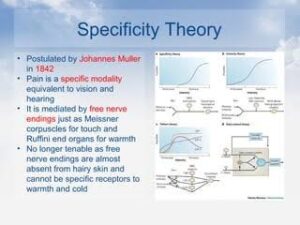
Specificity Theory
Many scientists continued to do research long after Descartes proposed the dualistic theory of pain. However, it wasn’t until 1811 that another well-known pain theory came onto the scene. This theory, initially presented by Charles Bell (1774–1842), is referred to as the specificity theory. This theory is similar to Descartes’ dualistic approach to pain in the way that it delineates different types of sensations to different pathways. In addition to the identification of specific pathways for different sensory inputs, Bell also postulated that the brain was not the homogenous object that Descartes believed it was, but instead a complex structure with various components. Scientists and philosophers alike spent the next century and a half further developing the specificity theory. One of the many contributors to this theory was Johannes Muller. In the mid-1800s, Muller published in the Manual of Physiology that individual sensations were the result of specific energy experienced at certain receptors. Furthermore, Muller believed that there was an infinite number of receptors in the skin, and this surplus of receptors accounted for the ability of an individual to discriminate between different sensations. In 1894, Maximillian von Frey made another critical addition to the specificity theory that served to advance the concept. This contribution to the theory was the discovery of the four separate somatosensory modalities found throughout the body. These sensations include cold, pain, heat, and touch. This concept correlates well with previous research done regarding this theory of pain, which served to reiterate the presence of distinct pathways for different sensations. Although this theory and the research surrounding it provided significant advancement to the understanding of pain, it still fails to account for factors other than those of physical nature that result in the sensation of pain. Much like the dualistic approach to pain, this theory also lacks an explanation for why sometimes pain persists long after the healing of the initial injury. This incomplete nature of the specificity theory regarding pain etiology necessitated additional theories and continued research.
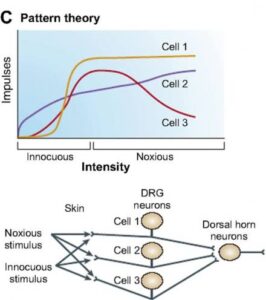
Pattern Theory
Following the specificity theory, there were a handful of other philosophies introduced regarding the sensation of pain. Of these philosophies, the pattern theory of pain has the greatest coverage in the scientific literature. The American psychologist John Paul Nafe (1888-1970) presented this theory in 1929. The ideas contained in the pattern theory were directly opposite to the ideas suggested in the Specificity theory in regards to sensation. Nafe indicated that there are no separate receptors for each of the four sensory modalities. Instead, he suggested that each sensation relays a specific pattern or sequence of signals to the brain. The brain then takes this pattern and deciphers it. Depending on which pattern the brain reads, correlates with the sensation felt. At the time of its introduction, the pattern theory gained significant popularity among many researchers. However, through further research and the discovery of unique receptors for each type of sensation, it can be stated with certainty, that this theory is an inaccurate explanation for how we feel pain.
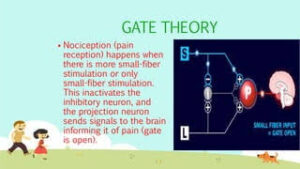
Gate Control Theory
In 1965, Patrick David Wall (1925–2001) and Ronald Melzack announced the first theory that viewed pain through a mind-body perspective. This theory became known as the gate control theory. Melzack and Wall’s new theory partially supported both of the two previous theories of pain but also presented more knowledge to advance the understanding of pain further. The gate control theory of pain states that when a stimulus gets sent to the brain, it must first travel to three locations within the spinal cord. These include the cells within the substantia gelatinosa in the dorsal horn, the fibers in the dorsal column, and the transmission cells which are located in the dorsal horn as well. The substantia gelatinosa of the spinal cord’s dorsal horn serves to modulate the signals that get through, acting similar to a “gate” for information traveling to the brain. The sensation of pain that an individual feels is the result of the complex interaction among these three components of the spinal cord. Simply stated, when the “gate” closes, the brain does not receive the information that is coming from the periphery to the spinal cord. However, when the signal traveling to the spinal cord reaches a certain level of intensity, the “gate” opens. Once the gate is open, the signal can travel to the brain where it is processed, and the individual proceeds to feel pain. The information mentioned above accounts for the physical component of pain, but as stated earlier, the Gate Control Theory was one of the first to acknowledge that psychological factors contributed to pain as well. In their original study, Melzack and Wall suggested that in addition to the control provided by the substantia gelatinosa, there was an additional control mechanism located in cortical regions of the brain. In more recent times, researchers have postulated that these cortical control centers are responsible for the effects of cognitive and emotional factors on the pain experienced. Current research has also suggested that a negative state of mind serves to amplify the intensity of the signals sent to the brain as well. For example, somebody who is depressed has a “gate” that is open more often, allowing more signals to get through, increasing the probability that an individual will experience pain from an otherwise normal stimulus. Also, there are reports that certain unhealthy lifestyle choices will also result in an “open gate,” which in turn leads to pain that is disproportionate to the stimulus. The gate control theory has proven to be one of the most significant contributions to the study of pain throughout history. The concepts that Melzack and Wall introduced to the study of pain are still utilized by researchers today. Even though this theory initiated the idea that pain wasn’t solely a result of physical injury but rather a complex experience, influenced by cognitive and emotional factors, there was still additional research necessary to comprehend the mechanisms and etiology of pain completely. This need precipitated the introduction of the following two philosophies regarding pain.
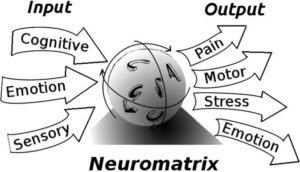
Neuromatrix Model
Almost thirty years after introducing the gate control theory of pain, Ronald Melzack introduced another model that contributed to the explanation of how and why people feel pain. Until the mid-1900s, most theories of pain implied that this experience was exclusively due to an injury that had occurred somewhere in the body. The thinking was that if an individual suffered an injury, whether it be through trauma, infection, or disease, a signal would transmit to the brain which would, in turn, result in the sensation of pain. Although Melzack had contributed to these previous theories, it was his exposure to amputees that were experiencing phantom limb pain in well-healed areas that prompted his inquiry into this more accurate philosophy of pain. The theory he proposed is known as the neuromatrix model of pain. This philosophy suggests that it is the central nervous system that is responsible for eliciting painful sensations rather than the periphery. The neuromatrix model denotes that there are four components within the central nervous system responsible for creating pain. The four components are the “body-self neuromatrix, the cyclic processing, and synthesis of signals, the sentinel neural hub, and the activation of the neuromatrix.” According to Melzack, the neuromatrix consists of multiple areas within the central nervous system that contribute to the signal, which allows for the feeling of pain. These areas include the spinal cord, brain stem and thalamus, limbic system, insular cortex, somatosensory cortex, motor cortex, and prefrontal cortex. The signal that these areas of the central nervous system work together to create is responsible for allowing an individual to feel pain, and he referred to as the “neurosignature.” Furthermore, this theory states that input coming in from the periphery can initiate or influence the neurosignature, but these peripheral signals cannot create a neurosignature of their own. This idea that peripheral signals can alter the neurosignature is an important concept when considering the effect that nonphysical factors have on an individual’s experience with pain. Melzack’s theory claimed that not only are there specific neurosignatures that elicit certain sensations, but when there is an alteration in a certain signal, this allows for memory formation of these particular experiences. If the same circumstances occur again in the future, it is this memory that allows for the same sensation to be felt. In addition to the hypothesis that pain was a product of different patterns of signals from the central nervous system, the neuromatrix model continued to elaborate on the idea that was initially brought forward in the gate control theory, that pain can be affected not only by physical factors but by cognitive and emotional factors. Melzack suggested that hyperactivity of the stress response has a direct effect on pain. Hyperactivity of the stress response is when an individual exposed to increased levels of stress experiences a higher level of pain. Taking all of these claims into consideration, it is evident that pain is a complex issue that cannot be accounted for by physical factors alone. Even though the neuromatrix model further established the idea that pain gets influenced by cognitive and emotional factors as well as physical factors, it still fails to account for social constructs of pain. Therefore, a new theory of pain must be utilized to appropriately explain the mechanism behind pain and why each individual’s experience with pain is unique.
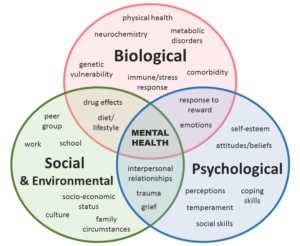
Biopsychosocial Model
The biopsychosocial model provides the most comprehensive explanation behind the etiology of pain. This specific theory of pain hypothesizes that pain is the result of complex interactions between biological, psychological, and sociological factors, and any theory which fails to include all of these three constructs of pain, fails to provide an accurate explanation for why an individual is experiencing pain. Although the term biopsychosocial was not introduced until 1954 by Roy Grinker (1900-1993), a neurologist and psychologist, there have been many physicians who had considered the utility of using such a model to approach the management of a patient’s pain long before this. One of the most prominent physicians who utilized this more comprehensive approach to pain was John Joseph Bonica (1917-1994), a Sicilian American anesthesiologist at Madigan Army Hospital, known as the founding father of the discipline of pain medicine. In the 1940s, Bonica was caring for many patients who had returned home from World War II and were now experiencing debilitating pain due to injuries they had suffered in the war. He had recognized that the pain these wounded soldiers were experiencing was rather complex and not easily managed. This situation led him to propose that to adequately manage these patients, physicians needed to create interprofessional pain clinics comprising multiple disciplines. At this moment in history, there was little support for the idea that pain was more than just the result of an injury, and Bonica was relatively unsuccessful in establishing these clinics. It wasn’t until 1977 that the biopsychosocial model was scientifically suggested as an explanation for the etiology of some medical conditions. George Engle claimed that to treat disease adequately, one must consider multidimensional concepts and manage the whole patient instead of focusing on a single issue. This methodology takes into account that the human body cannot be divided into separate categories when considering treatment options. Instead, it is beneficial to acknowledge the fact that illness and disease are the results of complex interactions between biological, psychological, and sociological factors, and they all affect an individual’s physical and mental well-being. Although Bonica had technically been the first physician to comprehend the importance of using a biopsychosocial approach to pain, John D. Loeser, another anaesthesiologist, has been credited as the first person to use this model in association with pain. Loeser suggested that four elements need to be taken into consideration when evaluating a patient with pain. These elements include nociception, pain, suffering, and pain behaviours. Nociception is the signal that is sent to the brain from the periphery to alert the body that there is some degree of injury or tissue damage. Pain, on the other hand, is the subjective experience that occurs after the brain has processed the nociceptive input. The last two components of pain that merit consideration is suffering and pain behaviours. The thinking is that suffering is an individual’s emotional response to the nociceptive signals and that pain behaviours are the actions that people carry out in response to the experience of pain. Both of these can be either conscious or subconscious. Loeser’s four elements of pain account for the biological, psychological, and sociological factors that can create or influence an individual’s experience with pain. Failing to consider any one of these four elements when determining the cause or establishing a management plan could be a consideration as inadequate assessment or care. With a better understanding of what is causing a patient to experience pain, the doctor is provided with a more accurate foundation to begin formulating a treatment plan. Loeser’s findings prove that the Biopsychosocial Model of pain offers the most comprehensive philosophy and provides the framework that is needed to start appropriate therapy to manage patients with chronic pain adequately.
Clinical Significance
Pain is the result of complex interactions between biological, psychological, and sociological factors that individuals experience, with no two individuals’ experiences being the same. It makes sense that an individual’s treatment approach should align with what it is treating. An appropriate method of treating pain must be multidimensional and tailored to individual experience. Utilizing the biopsychosocial model to treat chronic pain allows health practitioners to do just that. This model has been proven to have superior outcomes in terms of increased patient satisfaction and a better degree of restoration of functionality. In addition to this, it also is shown to be a more cost-effective method of treating patients with chronic pain, compared to other commonly used treatment plans. When taking all of this into consideration, it becomes quite evident that an interprofessional biopsychosocial model for the management of chronic pain should be the standard of care for all patients. Ethically speaking, when a means of decreasing a patient’s suffering exists, it should be utilized to its fullest capacity.
Addressing a patient who is suffering from chronic pain using a biopsychosocial approach provides the physician with the knowledge that is necessary to treat all factors contributing to pain instead of only treating the pain itself. There are multiple advantages to utilizing this type of model to address pain. One of the most critical benefits seen in clinics when this model is in use is a higher success rate in terms of increased functional capacity and patient satisfaction. This type of treatment focuses not on curing the problem but instead on gaining back maximal functional capacity. Certain specialties need to be included in a biopsychosocial treatment plan when managing patients with chronic pain to achieve this goal. These mandatory specialties include a primary care physician, psychiatrist or psychologist, physical therapist, occupational therapist, and sometimes a disability case manager. Multiple research studies evaluating the effectiveness of this approach have continuously shown that, versus other more traditional methods of managing pain, the biopsychosocial approach to pain allows for greater restoration of functionality. This type of treatment provides the patients with the tools that they need to take control of their pain, as opposed to letting their pain control them.
In addition to better outcomes and increased patient satisfaction, a biopsychosocial approach to pain management would serve to reduce the financial costs associated with caring for chronic pain patients. Research has been conducted comparing an interprofessional biopsychosocial pain management protocol to alternative methods. All the studies have come to the same conclusion: an interprofessional approach to pain management is 21 times more cost-effective compared to other methods. This reduction in cost can be attributed to a decreased need for pain medication, reduced calls for health care, and emergency room visits, and decreased disability payments. In a country where 17.5% of gross domestic product gets spent on health care, it would only be logical to implement methods that help to reduce some of this financial burden, and that is why applying an interprofessional approach to pain management is the obvious solution.
The Biopsychosocial Model is the only theory of pain that provides the most comprehensive explanation as to why people have pain as well as the unique nature of each patient’s experience. With chronic pain now considered a public health crisis, clinicians must alleviate suffering by trying all means possible instead of continuously using old methods that have been shown to be ineffective. In proceeding with future research on the concept of pain and its management, clinicians must maintain this biopsychosocial approach and continue to preserve the words of Aristotle, who was ahead of his time, in saying that “pain is quality of all senses.” Even with the availability of these new comprehensive approaches, it remains challenging to effectively manage pain and therefore, will continue to be a topic of future research.
References
- 1.
-
Cascella M, Thompson NS, Muzio MR, Forte CA, Cuomo A. The underestimated role of psychological and rehabilitation approaches for management of cancer pain. A brief commentary. Recenti Prog Med. 2016 Aug;107(8):418-21. [PubMed]
- 2.
-
Spofford CM, Brennan TJ. Gene expression in skin, muscle, and dorsal root ganglion after plantar incision in the rat. Anesthesiology. 2012 Jul;117(1):161-72. [PMC free article] [PubMed]
- 3.
-
Cascella M, Muzio MR. Pain insensitivity in a child with a de novo interstitial deletion of the long arm of the chromosome 4: Case report. Rev Chil Pediatr. 2017 Jun;88(3):411-416. [PubMed]
- 4.
-
Miceli L, Bednarova R, Rizzardo A, Cuomo A, Riccardi I, Vetrugno L, Bove T, Cascella M. Opioids prescriptions in pain therapy and risk of addiction: a one-year survey in Italy. Analysis of national opioids database. Ann Ist Super Sanita. 2018 Oct-Dec;54(4):370-374. [PubMed]
- 5.
- 6.
-
Perl ER. Pain mechanisms: a commentary on concepts and issues. Prog Neurobiol. 2011 Jun;94(1):20-38. [PMC free article] [PubMed]
- 7.
-
Moayedi M, Davis KD. Theories of pain: from specificity to gate control. J Neurophysiol. 2013 Jan;109(1):5-12. [PubMed]
- 8.
-
Bernhard Naunyn (1839-1925), clinician, teacher, scientist. JAMA. 1969 May 19;208(7):1182-3. [PubMed]
- 9.
-
Dedeli O, Kaptan G. Spirituality and Religion in Pain and Pain Management. Health Psychol Res. 2013 Sep 24;1(3):e29. [PMC free article] [PubMed]
- 10.
-
Duncan G. Mind-body dualism and the biopsychosocial model of pain: what did Descartes really say? J Med Philos. 2000 Aug;25(4):485-513. [PubMed]
- 11.
-
Mehta N. Mind-body Dualism: A critique from a Health Perspective. Mens Sana Monogr. 2011 Jan;9(1):202-9. [PMC free article] [PubMed]
- 12.
-
Pearce JM. Von Frey’s pain spots. J Neurol Neurosurg Psychiatry. 2006 Dec;77(12):1317. [PMC free article] [PubMed]
- 13.
-
Melzack R. Evolution of the neuromatrix theory of pain. The Prithvi Raj Lecture: presented at the third World Congress of World Institute of Pain, Barcelona 2004. Pain Pract. 2005 Jun;5(2):85-94. [PubMed]
- 14.
- 15.
-
Ropero Peláez FJ, Taniguchi S. The Gate Theory of Pain Revisited: Modeling Different Pain Conditions with a Parsimonious Neurocomputational Model. Neural Plast. 2016;2016:4131395. [PMC free article] [PubMed]
- 16.
-
Garland EL. Pain processing in the human nervous system: a selective review of nociceptive and biobehavioral pathways. Prim Care. 2012 Sep;39(3):561-71. [PMC free article] [PubMed]
- 17.
-
Nijs J, D’Hondt E, Clarys P, Deliens T, Polli A, Malfliet A, Coppieters I, Willaert W, Tumkaya Yilmaz S, Elma Ö, Ickmans K. Lifestyle and Chronic Pain across the Lifespan: An Inconvenient Truth? PM R. 2020 Apr;12(4):410-419. [PubMed]
- 18.
-
Senba E, Kami K. A new aspect of chronic pain as a lifestyle-related disease. Neurobiol Pain. 2017 Jan-Jul;1:6-15. [PMC free article] [PubMed]
- 19.
- 20.
-
Meints SM, Edwards RR. Evaluating psychosocial contributions to chronic pain outcomes. Prog Neuropsychopharmacol Biol Psychiatry. 2018 Dec 20;87(Pt B):168-182. [PMC free article] [PubMed]
- 21.
-
Jensen MP, Turk DC. Contributions of psychology to the understanding and treatment of people with chronic pain: why it matters to ALL psychologists. Am Psychol. 2014 Feb-Mar;69(2):105-18. [PubMed]
- 22.
-
Ghaemi SN. The rise and fall of the biopsychosocial model. Br J Psychiatry. 2009 Jul;195(1):3-4. [PubMed]
- 23.
-
Lugg W. The biopsychosocial model – history, controversy and Engel. Australas Psychiatry. 2022 Feb;30(1):55-59. [PubMed]
- 24.
-
Sen S, Martin DP, Bacon DR. Exploring origins: was John Bonica’s model of modern-day pain management influenced by John Lundy’s earlier work? Reg Anesth Pain Med. 2007 May-Jun;32(3):258-62. [PubMed]
- 25.
- 26.
-
Peng P, Stinson JN, Choiniere M, Dion D, Intrater H, LeFort S, Lynch M, Ong M, Rashiq S, Tkachuk G, Veillette Y., STOPPAIN Investigators Group. Role of health care professionals in multidisciplinary pain treatment facilities in Canada. Pain Res Manag. 2008 Nov-Dec;13(6):484-8. [PMC free article] [PubMed]
- 27.
-
Sokol RG, Pines R, Chew A. Multidisciplinary Approach for Managing Complex Pain and Addiction in Primary Care: A Qualitative Study. Ann Fam Med. 2021 May-Jun;19(3):224-231. [PMC free article] [PubMed]
- 28.
-
Mescouto K, Olson RE, Hodges PW, Setchell J. A critical review of the biopsychosocial model of low back pain care: time for a new approach? Disabil Rehabil. 2022 Jun;44(13):3270-3284. [PubMed]
- 29.
-
Darnall BD, Carr DB, Schatman ME. Pain Psychology and the Biopsychosocial Model of Pain Treatment: Ethical Imperatives and Social Responsibility. Pain Med. 2017 Aug 01;18(8):1413-1415. [PMC free article] [PubMed]
-
Disclosure: Lindsay Trachsel declares no relevant financial relationships with ineligible companies.
-
Disclosure: Sunil Munakomi declares no relevant financial relationships with ineligible companies.
-
Disclosure: Marco Cascella declares no relevant financial relationships with ineligible companies.
